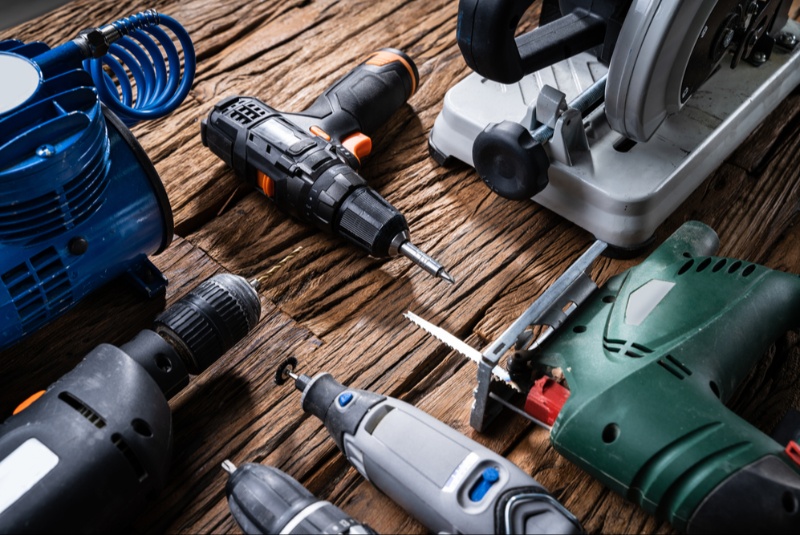Embarking on DIY projects requires not just skill and creativity but also the right set of tools. Power tools are indispensable for a variety of tasks, from basic home repairs to complex renovations. Choosing the right power tools involves understanding your project requirements, evaluating the tools’ features, and ensuring they align with your skill level and safety standards.
Understanding Different Types of Power Tools
The power tool market is vast, with tools designed for specific tasks. Drills, for example, are essential for making holes and driving screws, while saws are used for cutting materials like wood and metal. Sanders are ideal for smoothing surfaces, and grinders are used for cutting and polishing. Understanding the function of each tool and how it aligns with your projects is the first step in making an informed purchase.
Evaluating the Power Source: Corded vs. Cordless
Deciding between corded and cordless power tools depends on your specific needs. Corded tools generally offer more power and run time, making them suitable for heavy-duty tasks or prolonged use. Cordless tools, powered by rechargeable batteries, offer unparalleled portability and convenience, ideal for tasks away from power outlets or in tight spaces. Consider the nature of your projects and the environment you'll be working in when choosing between these two types.
Assessing Tool Power and Performance
The power and performance of a tool are crucial to its effectiveness. The tool’s voltage (for cordless tools) and amp rating (for corded tools) are indicators of its power. Higher ratings typically mean the tool can handle more demanding tasks. Consider the materials you'll be working with and the level of power required to efficiently complete your projects.
Choosing the Right Tool for the Job
Each DIY project has unique requirements, and using the right tool for the job is essential for both efficiency and safety. For instance, a miter saw is ideal for making precise crosscuts and miters, while a reciprocating saw is better suited for demolition tasks. Research your project’s requirements thoroughly to ensure you select the most appropriate tools.
Durability and Build Quality
Durability is a key factor, especially for tools that will be used frequently or for demanding tasks. Tools with robust construction and high-quality materials can withstand rigorous use and harsh conditions. This durability ensures your investment is protected and the tools remain reliable over time.
Ergonomic Design for User Comfort
Comfort and ease of use are vital, particularly for tasks that require extended use of the tools. Ergonomically designed tools with features like padded grips, vibration reduction, and lightweight construction can significantly reduce user fatigue and increase efficiency. An ergonomic design also contributes to better control and precision in your work.

Safety Features and Precautions
Power tools can be dangerous if not used properly. Essential safety features include automatic shut-offs, blade guards, and non-slip handles. Familiarize yourself with each tool's safety mechanisms and always adhere to recommended safety practices, including wearing appropriate protective gear.
Budget and Cost-Effectiveness
Budget considerations are crucial when selecting power tools. While higher-end models offer advanced features and greater durability, there are also many affordable options that provide adequate quality for most DIY tasks. Consider your frequency of use and the demands of your projects to find a balance between cost and quality.
Brand Reputation and Reliability
The brand’s reputation can be a reliable indicator of tool quality and performance. Brands with a long-standing positive reputation in the market are often synonymous with quality and reliability. Researching brand history and customer feedback can provide insights into the performance and longevity of their products.
Warranty and After-Sales Support
A strong warranty and efficient after-sales support are indicative of the manufacturer's confidence in their product. Look for brands that offer comprehensive warranties and responsive customer service. This support can be invaluable in addressing any issues or queries you might have in the future.
Reading Reviews and Gathering User Feedback
Customer reviews and feedback offer real-world insights into a tool's performance, durability, and usability. Online forums, product review sites, and DIY communities are excellent resources for unbiased opinions. Pay attention to recurring comments, as they often highlight the strengths and weaknesses of the tools.
Testing the Tools Before Purchase
If possible, try out the tools before finalizing your purchase. This hands-on experience allows you to assess the tool's weight, balance, ergonomics, and ease of use. Many home improvement stores offer demonstration models that you can test to get a feel for the tool's performance.
Considering the Environmental Impact
In an age where sustainability is key, consider the environmental impact of your power tool choices. Opt for brands that prioritize eco-friendly manufacturing processes and energy-efficient designs. Cordless tools with lithium-ion batteries, for example, are not only more efficient but also have a lesser environmental impact than traditional battery types.
Tailoring Your Selection to Your Skill Level
Choose tools that match your skill level to ensure safety and successful project outcomes. Beginners might prefer tools with straightforward functions and user-friendly designs, while experienced DIYers may opt for more sophisticated tools with advanced features. Selecting tools that align with your skills can enhance your DIY experience and encourage skill development.
Selecting the right power tools for DIY projects involves a careful consideration of tool types, power sources, performance, durability, ergonomics, safety, budget, brand reputation, and environmental impact. By thoroughly evaluating these factors, you can equip yourself with the tools necessary to successfully and safely complete a wide range of DIY projects, enhancing your skills and enjoyment in the process.




